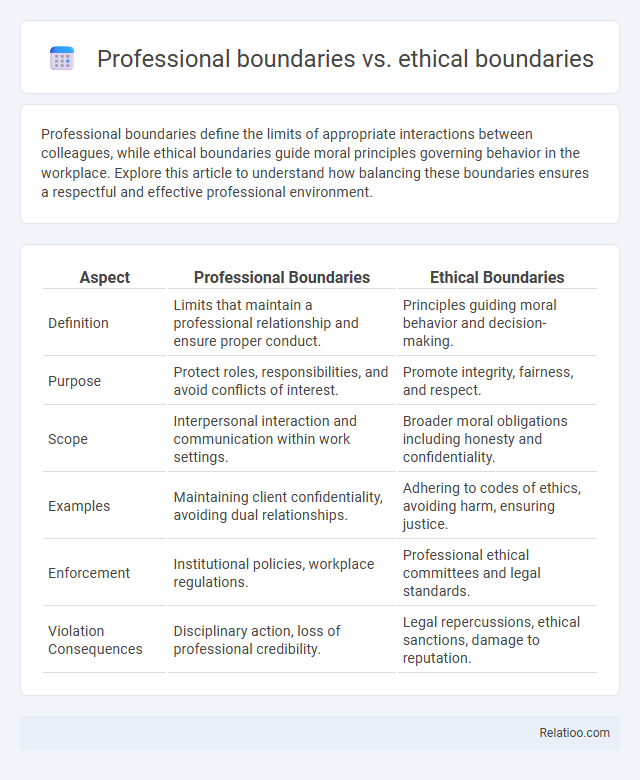Professional boundaries define the limits of appropriate interactions between colleagues, while ethical boundaries guide moral principles governing behavior in the workplace. Explore this article to understand how balancing these boundaries ensures a respectful and effective professional environment.
Table of Comparison
| Aspect | Professional Boundaries | Ethical Boundaries |
|---|---|---|
| Definition | Limits that maintain a professional relationship and ensure proper conduct. | Principles guiding moral behavior and decision-making. |
| Purpose | Protect roles, responsibilities, and avoid conflicts of interest. | Promote integrity, fairness, and respect. |
| Scope | Interpersonal interaction and communication within work settings. | Broader moral obligations including honesty and confidentiality. |
| Examples | Maintaining client confidentiality, avoiding dual relationships. | Adhering to codes of ethics, avoiding harm, ensuring justice. |
| Enforcement | Institutional policies, workplace regulations. | Professional ethical committees and legal standards. |
| Violation Consequences | Disciplinary action, loss of professional credibility. | Legal repercussions, ethical sanctions, damage to reputation. |
Understanding Professional Boundaries
Understanding professional boundaries involves recognizing clear limits that safeguard the integrity of the client-provider relationship, preventing conflicts of interest and misuse of power. Ethical boundaries extend these limits by embedding moral principles and standards set by professional organizations to guide behavior and decision-making. Professional boundary maintenance ensures trust, confidentiality, and respect, which are crucial for effective and ethical practice across various fields like healthcare, counseling, and social work.
Defining Ethical Boundaries
Ethical boundaries define the moral principles guiding your professional conduct, ensuring respect, fairness, and integrity in interactions. Unlike professional boundaries that regulate role-specific behaviors and limits, ethical boundaries emphasize the overarching values that protect client welfare and uphold trust. Clear ethical boundaries prevent conflicts of interest and promote accountability within your professional practice.
Key Differences Between Professional and Ethical Boundaries
Professional boundaries define the limits of acceptable behavior and relationships in a work setting, ensuring roles and responsibilities are clearly maintained, while ethical boundaries are grounded in moral principles guiding what is right or wrong beyond formal rules. The key difference between professional and ethical boundaries lies in their scope: professional boundaries emphasize role-specific limitations and workplace conduct, whereas ethical boundaries encompass broader moral obligations such as confidentiality, integrity, and respect. Understanding these distinctions is crucial for maintaining trust, protecting clients, and upholding organizational standards in various professions.
Importance of Maintaining Boundaries in the Workplace
Maintaining professional and ethical boundaries in the workplace is crucial to fostering a respectful, productive environment where trust and accountability thrive. Clear boundaries prevent conflicts of interest, uphold confidentiality, and ensure that interactions remain appropriate and aligned with organizational values and legal standards. Prioritizing these boundaries enhances team cohesion, protects employee well-being, and supports strong leadership practices essential for long-term success.
Common Examples of Professional Boundary Issues
Professional boundary issues commonly arise when personal relationships interfere with workplace objectivity, such as favoritism or inappropriate communications. Ethical boundaries are breached through actions like confidentiality violations or conflicts of interest, undermining trust and integrity in your profession. Maintaining clear professional boundaries involves respecting personal space, avoiding dual relationships, and upholding appropriate conduct to ensure a respectful and effective work environment.
Ethical Dilemmas and Boundary Violations
Ethical boundaries define the moral principles guiding professional conduct, ensuring decisions prioritize integrity and client welfare, while professional boundaries establish the limits of the client-provider relationship to maintain trust and objectivity. Boundary violations occur when these limits are breached, often leading to ethical dilemmas where Your role and responsibilities may conflict with personal feelings or external pressures. Recognizing and respecting both professional and ethical boundaries is crucial to prevent harm and uphold the standards of the profession.
Impact of Boundary Breaches on Client Relationships
Boundary breaches in professional and ethical contexts undermine trust and compromise client relationships, leading to diminished communication and potential harm. Violations of professional boundaries, such as inappropriate dual relationships or confidentiality breaches, result in loss of client confidence and possible legal ramifications. Maintaining clear ethical boundaries ensures respect, safety, and integrity, which are essential for effective therapeutic or service outcomes.
Strategies for Establishing Clear Boundaries
Strategies for establishing clear professional, ethical, and professional boundaries include setting explicit communication norms, defining roles and responsibilities, and regularly reviewing organizational policies to ensure alignment with ethical standards. Utilizing training programs and workshops helps reinforce understanding of acceptable behaviors and decision-making frameworks within professional contexts. Employing consistent feedback mechanisms enables timely correction of boundary violations, fostering a culture of respect and accountability.
Legal Implications of Boundary Violations
Professional boundaries define the limits of appropriate relationships and interactions within a work context, while ethical boundaries encompass broader moral principles guiding conduct. Violating professional or ethical boundaries can lead to serious legal implications, including lawsuits for malpractice, breach of confidentiality, or harassment. Understanding these distinctions helps you protect your legal rights and maintain compliance with regulatory standards.
Best Practices for Navigating Professional and Ethical Boundaries
Professional boundaries define the limits of appropriate interactions between colleagues and clients, ensuring respect, trust, and role clarity. Ethical boundaries encompass moral principles guiding behavior, confidentiality, and decision-making within professional contexts. Best practices for navigating these boundaries include maintaining clear communication, adhering to organizational policies, seeking supervision or peer consultation when uncertain, and consistently reflecting on the impact of decisions to prevent conflicts of interest and uphold integrity.

Infographic: Professional boundaries vs Ethical boundaries
 relatioo.com
relatioo.com